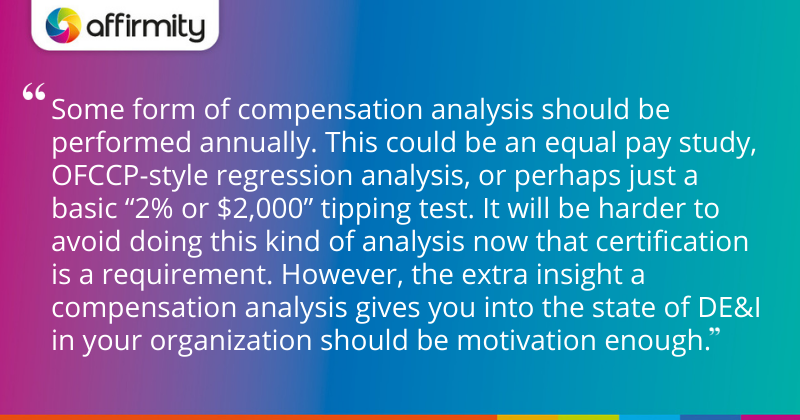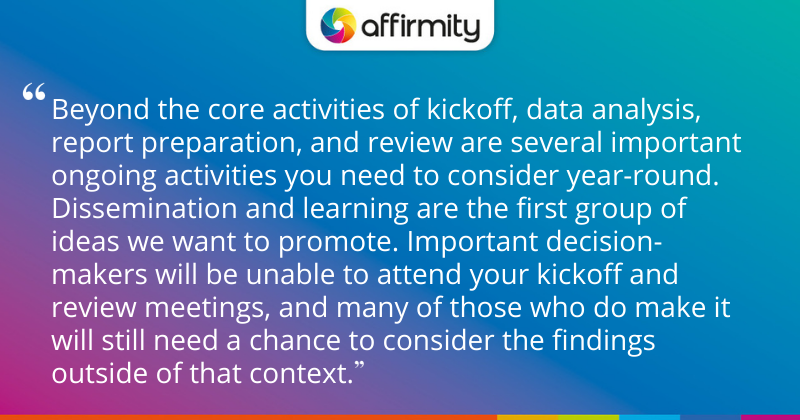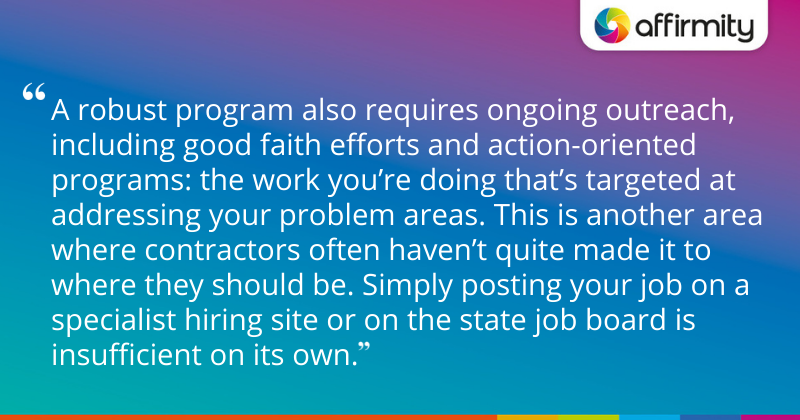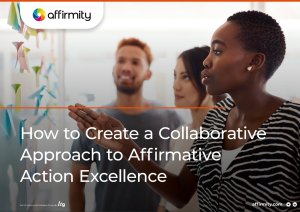We’ve talked previously about the interface of the OFCCP’s new contractor portal and the practical implications for your affirmative action plan. But what does it actually look like when your program could be definitively considered compliant? The answer is that instead of thinking about the work in terms of just the AAP reports you must produce, you will have to look at your program overall and consider its ongoing maintenance.
This ongoing work has several different components that we’ll explore in this article, with examples of when we would suggest scheduling based on a January plan date.
1) Project Kickoff – December
Typical activities:
- Assemble project teams
- Schedule kickoff meeting
- Define plan structure(s)
- Discuss data specifications
- Identify additional data fields and reporting requirements
- Identify and set up Affirmity’s Complete Resource Center (CRC) users
- Identify report distribution processes
We would recommend meeting a month ahead of your plan date for kickoff activity (we’re working to a January plan date in this example, so suggest meeting in December). Firstly, take the opportunity to have a kickoff meeting in which you discuss the data and any significant changes. This will help you factor what your business currently looks like into the plans you’re about to prepare.
This is your opportunity to get ahead of some of the decisions and admin that will need to be made before you pull the data in the next month. Work with the relevant parties to define plan structures, data specifications, and eventual distribution of the reports. If building off a previous year’s work, you may need to look at additional data fields, and new reporting requirements to factor in.
If you have a software solution on your side, such as Affirmity’s own Complete Resource Center (CRC), you can save some time by ensuring that all users are ready to go during this kickoff month.
MORE ON DIVERSITY DATA | ‘4 Factors That Will Keep Your Talent Acquisition Data Clean for DE&I’

2) Data and Compensation Analysis – January
Typical activities:
- Employee snapshot data
- Applicant data and disposition reasons
- Hires, terminations, and promotions
- Review of data files for completeness
- Clarification of questions regarding data
- Data reconciliation
Compensation analysis options:
- 2% or $2,000 tipping test
- OFCCP-style regression analysis
- Equal pay study
When it comes to pulling the data for your plan date month, you’ll want to go through a robust program of gathering and reconciling the data. It’s critical to ensure that your plans are accurate, so this means checking that employees are where they belong, and are accurately and completely recorded. This is also the appropriate time to look at compensation—something that too many contractors don’t do at all, or at least as often as they should.
Some form of compensation analysis should be performed annually. This could be an equal pay study, OFCCP-style regression analysis, or perhaps just a basic “2% or $2,000” tipping test. It will be harder to avoid doing this kind of analysis now that certification is a requirement. However, the extra insight a compensation analysis gives you into the state of DE&I in your organization should be motivation enough.
3) Report Preparation & Review – March
Typical activities:
- Finalize plans
- Conduct AAP assessment
- Find AAP insights
- Create narratives
- Hold report review meeting(s)
- Discuss adverse impact
- Discuss repeat goals
- Identify next steps after reviewing AAP reports (training, outreach, monitoring, etc.)
The previous steps obviously build toward the execution of your program, and we’ve outlined some of the typical activities above when preparing reports with Affirmity support and solutions. Beyond the steps required to simply prepare the reports, we would highlight the importance of reviewing them: just as you did at project kickoff, hold a meeting and use this to discuss your findings. Subjects such as adverse impact and repeat goals should be a focus.
Most importantly—and perhaps most regularly ignored—this is the time to discuss your next steps. Having expended all this effort to create the reports ready for certification, you should not (and cannot!) put it on the shelf for next year. Use your reports review meeting(s) to recommend, identify, and agree on your next steps, be that training, outreach, or monitoring.
DISCOVER AUDIT PREPARATION TOOLS | ‘Tools and Processes to Help You Prepare for OFCCP Audits’

4) Dissemination & Learning – Upon Completion of Plans
Dissemination of data to:
- Executive leadership
- Plan owners
- Recruiters
Required, or highly recommended, training:
- Affirmative Action Compliance for Managers
- Principles of Recruiter Compliance
- Compliance with Section 503 and VEVRAA
Additional training:
Beyond the core activities of kickoff, data analysis, report preparation, and review are several important ongoing activities you need to consider year-round. Dissemination and learning are the first group of ideas we want to promote. Important decision-makers will be unable to attend your kickoff and review meetings, and many of those who do make it will still need a chance to consider the findings outside of that context. Then, the business at large needs to receive the training opportunities that are needed for real cultural change.
Naturally, you need to disseminate your data, your reports, and your findings to those making employment and compensation decisions. So this will certainly include making sure your recruiters and hiring managers understand any placement goals you have, and any obligations towards veterans and individuals with disabilities. Groups such as executives should also be aware of the responsibilities and goals.
Then, of course, the wider business should be benefiting from AAP-related training on key subjects such as affirmative action for managers and recruiters. In order to address specific issues, you may also opt to focus on specific topics such as unconscious bias.
5) Outreach – Ongoing
Action-oriented programs:
- List openings with the state employment agency
- Create targeted programs to address placement goals
- Track progress made toward any placement goals
Measure outreach effectiveness:
- Review good faith efforts
- Ensure ongoing outreach to protected groups
- Evaluate effectiveness of each effort individually and the program overall
A robust program also requires ongoing outreach, including good faith efforts and action-oriented programs: the work you’re doing that’s targeted at addressing your problem areas. This is another area where contractors often haven’t quite made it to where they should be. Simply posting your job on a specialist hiring site or on the state job board is insufficient on its own.
Your organization needs to establish relationships while tracking and evaluating each aspect of what you do to prove if it works (and making changes so that it does). As we’ve seen elsewhere, the need to up your game in this area ultimately benefits your business. It never hurts to know where dollars are being wasted!
FURTHER THOUGHTS ON GOOD FAITH EFFORTS | ‘The Why, How, and What of Good Faith Efforts: Why GFEs Are Important’

6) Everything Else – Ongoing
There is plenty more that organizations need to do on an ongoing basis to ensure full compliance. This includes monitoring your progress throughout the year, performing a steps analysis, investigating adverse impact, and performing internal audits. Take regular opportunities to look at your organization, what you’re doing, whether it’s working, and whether it meets the goals you’ve set for yourself. Stay ahead of the certification process, so that you don’t suddenly have to investigate everything before the deadline, and your efforts will start to evolve and improve your workplace.
Go Beyond Certification: Create a Collaborative Approach to Affirmative Action Excellence
With the OFCCP intently focused on checking that AAPs are not only in place in a timely fashion, but updated annually, it’s a great time to consider how your plans could be doing more for your organizations all year round. Our guide, “How to Create a Collaborative Approach to Affirmative Action Excellence” explains the tweaks to your process that will futureproof your planning.
Download the full guide today.

